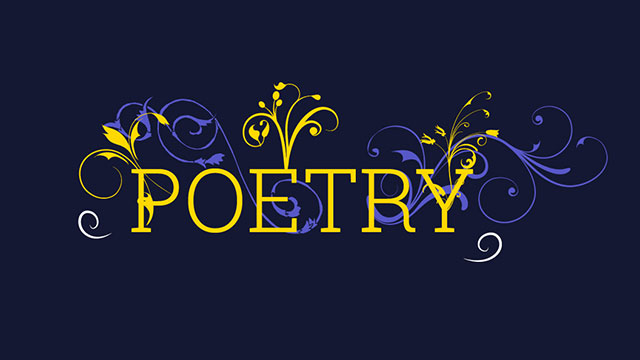Table of Contents
NOT JUST YOUR ORDINARY POEMS
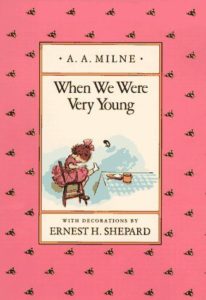
|
A.A. Milne’s When We Were Very Young (Dutton Juvenile, 2009), originally published in 1924, includes such favorites as “Disobedience,” the story of James James Morrison Morrison Weatherby George Dupree and his sadly straying mother, and “The King’s Breakfast,” in which the king simply wants a little butter for his bread. Follow this one up with Now We Are Six (Dutton Juvenile, 2008). For ages 3 and up. |
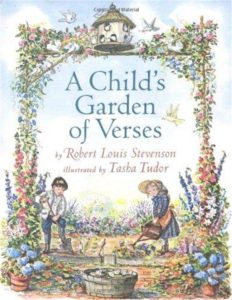
|
Robert Louis Stevenson’s A Child’s Garden of Verses (available in many editions), first published in 1885, includes such time-honored favorites as “Bed in Summer,” “Windy Nights,” “The Land of Counterpane,” and “The Unseen Playmate.” Particularly beautiful versions are those illustrated by Brian Wildsmith (Star Bright, 2008) and Barbara McClintock (HarperCollins, 2011). For ages 4-8. |
| The text of A Child’s Garden of Verses is online at the Poetry Lovers page. | |
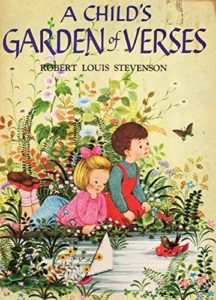 |
From Dover Publications, A Child’s Garden of Verses Coloring Book has a selection of Stevenson’s poems with accompanying blackline ready-to-color illustrations by Nancy Haase Tafuri. |
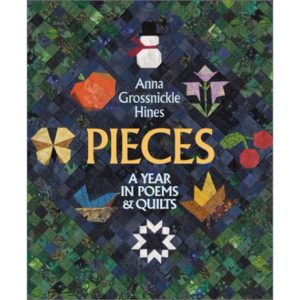
|
By Anna Grossnickle Hines, Pieces: A Year in Poems and Quilts (Greenwillow Books, 2003) is a collection of seasonal poems illustrated with quilt blocks. For ages 4 and up. |
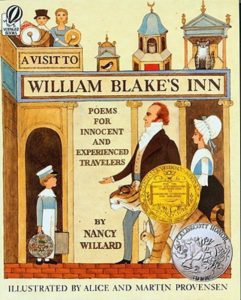
|
Nancy Willard’s Newbery-winner, A Visit to William Blake’s Inn (Sandpiper, 1982), with beautiful illustrations by Alice and Martin Provensen, is a creative collection of poems based on Blake’s Songs of Innocence and Songs of Experience. Titles include “A Rabbit Reveals My Room,” “The Sun and Moon Circus Soothes the Wakeful Guests,” “The Man in the Marmalade Hat Arrives,” and “The Tiger Asks Blake for a Bedtime Story.” Not to be missed. For all ages. |
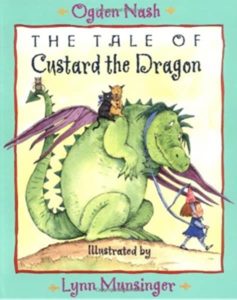
|
Ogden Nash’s The Tale of Custard the Dragon (Little, Brown Books for Young Readers, 1998) is a picture-book version of the rollicking rhyming tale of Belinda and Custard, her “realio, trulio little pet dragon” – and a total coward until the fatal day when Belinda is attacked by a pirate. For ages 4-8. |
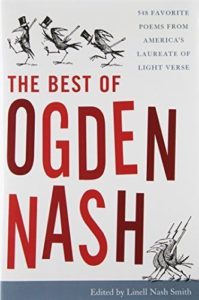
|
The Best of Ogden Nash (Ivan R. Dee, 2007) is the definitive Nash anthology, 548 poems by America’s “poet laureate of light verse.” For all ages. |
| From AllPoetry, Poems of Ogden Nash includes such favorites as “The Adventures of Isabel” (“Isabel met an enormous bear/Isabel, Isabel didn’t care”). | |
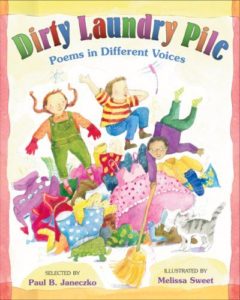
|
Compiled by Paul Janeczko, Dirty Laundry Pile (HarperCollins, 2001) is an imagination-expanding collection of “poems in different voices,” with lovely watercolor illustrations by Melissa Sweet. Among the voices are those of a shell, a scarecrow, a snowflake, a turtle, and even – yes – a pile of dirty laundry. For ages 4 and up. |
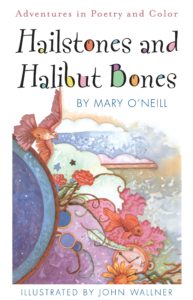
|
Mary O’Neill’s Hailstones and Halibut Bones (Doubleday Books for Young Readers, 1990), originally published in 1961, is an illustrated collection of twelve poems about colors, each introduced with “What Is…?” “What Is Black?,” for example, begins “Black is the night/When there isn’t a star…” Not only a lovely read, but a great start for writing color poems of your own. For ages 4-9. |
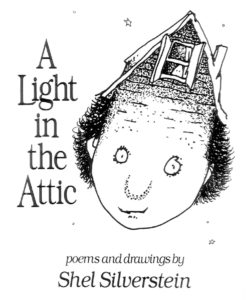
|
Shel Silverstein’s cleverly subversive collections of verse include A Giraffe and a Half (HarperCollins, 1964), Where the Sidewalk Ends (HarperCollins, 1974), A Light in the Attic (HarperCollins, 1981), and Falling Up (HarperCollins, 1996). For ages 5 and up. |
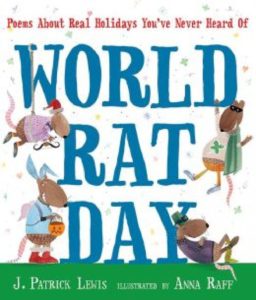
|
J. Patrick Lewis’s World Rat Day (Candlewick, 2013) is a poetic celebration of such real-but-neglected holidays as Dragon Appreciation Day, World Turtle Day, and International Cephalopod Awareness Day. For ages 5-8. |
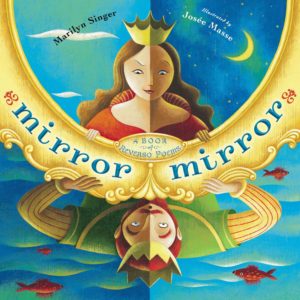
|
Marilyn Singer’s Mirror Mirror (Dutton Juvenile, 2010) and sequel Follow Follow (Dial, 2013) are fascinating collections of palindromic poems – “reversos” – that put a whole new spin on familiar fairy tales. The poems are paired side by side on a page – first read forward, then backward – and there lies all the difference: the story of Hansel and Gretel, for example, read forward, is narrated by the witch, urging Hansel to fatten up; read backwards, it’s a caution to do just the opposite. Included are instructions for writing reversos of your own. A cool project for ages 7 and up. |
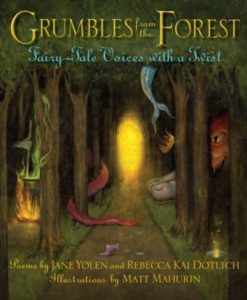
|
By Jane Yolen and Rebecca Kai Dotlich, Grumbles from the Forest (Wordsong, 2013) is an illustrated collection of fifteen classic fairy tales told with a twist, through paired poems. Beauty daydreams before her marriage (“I can’t get past/ his fangs, his roar”) and then writes nostalgically on a distant anniversary (“Beast and I/putter in the garden…I have no regrets/None.”). Cinderella complains about the glass slipper (“I could have put on/moccasins”) and the stepsisters complain of her move to the palace; the Princess and the Pea both present their points of view. Kids will want to invent their own fairy-tale character poems. For ages 7 and up. |
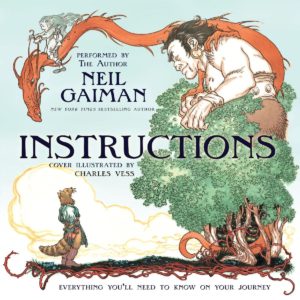
|
Neil Gaiman’s Instructions (HarperCollins, 2010), the picture-book version of a poem that first appeared in A Wolf at the Door and Other Retold Fairy Tales (Aladdin, 2001), are magical step-by-step directions for navigating a fairy-tale landscape. (“Trust the wolves, but do not tell them where you are going.”) All ages. |
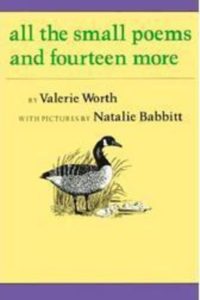
|
Valerie Worth’s All the Small Poems and Fourteen More (Square Fish, 1996) is a collection of over 100 “small poems” celebrating the wonders of the everyday. The table of contents alone might serve as poem starters for potential poetry writers: Worth’s (lower-case) titles include “cow,” “duck,” “door,” “daisies,” “crickets,” “acorn,” “flamingo,” “haunted house,” “soap bubble,” and “lions.” All ages. |
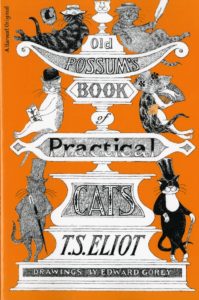
|
T.S. Eliot’s Old Possum’s Book of Practical Cats (Harcourt Children’s Books), originally published in 1939, is a collection of the wonderful poems that inspired Andrew Lloyd Webber’s musical Cats. Poems include such favorites as “The Naming of Cats,” “Mr. Mistoffelees,” and “Macavity: The Mystery Cat.” For all ages. |
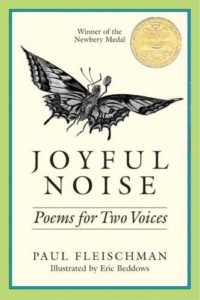
|
Paul Fleischman’s Newbery winner Joyful Noise (HarperCollins, 2004) is a collection of fourteen terrific poems about insects – everything from the firefly to the cricket, book louse, mayfly, and honeybee – all designed to be read in two alternating voices. For ages 8 and up. |
| Also by Fleischman, see I Am the Phoenix (HarperCollins, 1989), fifteen poems for two voices, all about birds. | |
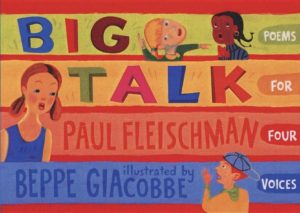
|
More voices! Paul Fleischman’s Big Talk: Poems for Four Voices (Candlewick, 2008) is a collaborative poetry experience in which each reader chooses a color (green, yellow, orange, or purple) and then reads the appropriate color-coded lines of the poem. For ages 9-13. |
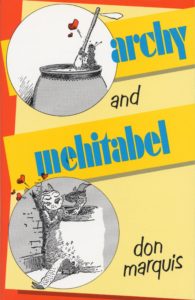
|
In Don Marquis’s archy and mehitabel (Anchor, 1987), originally published in 1927, archy is a highly literate cockroach who types by leaping on the typewriter keys (he can’t use the Shift key; hence no capital letters) and his friend mehitabel, an alley cat, who claims in a past life to have been Cleopatra. archy’s reflections on life, all in free verse, are now an American classic. For ages 13 and up. |
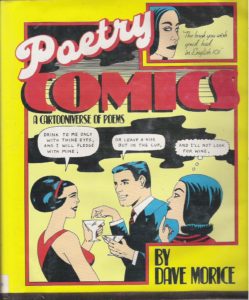
|
David Morice’s Poetry Comics (Teachers & Writers Books, 2002) is an irreverent and hilarious collection of classic poems, unconventionally illustrated. Shakespeare’s Sonnet 18 (“Shall I compare thee to a summer’s day?”), for example, is recited by monsters; both Walt Whitman and Edgar Allan Poe’s Raven are depicted as superheroes; and “I think that I shall never see/A poem lovely as a tree” – when spoken by a tree – becomes a tree-style pick-up ploy. Included are instructions for making your own poetry comics. For teenagers and adults. |
